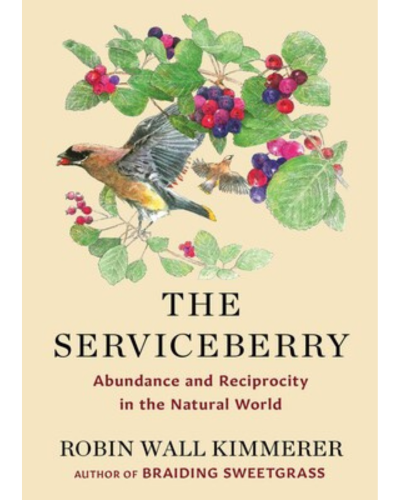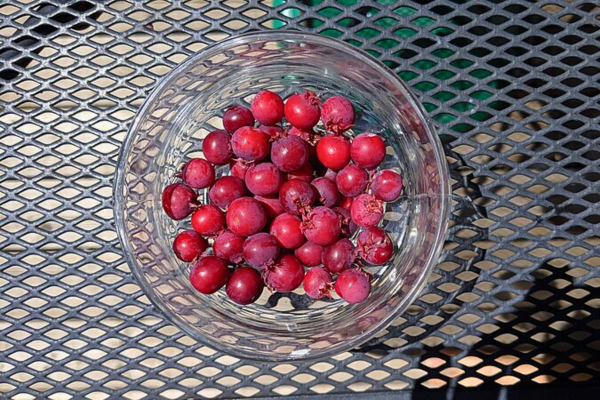
Picture yourself standing beneath a mature serviceberry tree, soaking in the beauty of its branches covered in white spring blossoms, or snacking on its juicy, dark-red berries in the summer. Imagine pollinators and other insects as they buzz through the branches in spring or birds chirping as they share in the delicious summer bounty offered by the serviceberry. This idyllic image represents the intertwined nature of life on earth that forms the core message of botanist, professor and Citizen Potawatomi Nation member, Robin Wall Kimmerer’s new book. Using the native serviceberry (Amelanchier laevis) as a guide, Kimmerer envisions a more sustainable future for our society where we exist in harmony with nature through a gift-based economy of reciprocity and mutual care.
The back cover of the book features a simple but powerful phrase: “All Flourishing is Mutual.” This idea forms the foundation of Kimmerer’s exploration of gift-giving economies. For us to thrive, the ecosystems we exist within must thrive too. Or more simply, we flourish when nature flourishes.

Now consider how our current capitalist economy discourages mutual flourishing. Founded on concepts of competition and scarcity, our economy encourages unsustainable resource extraction and hoarding, profit maximization and the accumulation of personal wealth. On a global scale, these patterns harm both human and non-human life. In contrast, a gift-giving economy values abundance and mutual care and provides us with a more compassionate and sustainable path forward.
So, what does this alternative gift-giving economy look like? Kimmerer points to nature itself. Nature freely gifts us with fresh air, healthy soil and clean water. Like a parent caring for a child, nature shares its resources (gifts) with us out of love and care rather than a desire to profit. Kimmerer explains that when a gift is received, a relationship based on gratitude and responsibility can be built. As a role model for gift-giving, the serviceberry tree shows how acts of generosity can build lasting relationships of reciprocity.
The tree generously provides its gifts, including flowers, berries and habitat to people, insects, birds and other animals. In return, the serviceberry gets the opportunity to spread its seeds. This reciprocity allows the tree and the many lives it supports to flourish together. It also creates opportunities for building new relationships between human and non-human beings who come together to share in its bounty.

How can you help to create this alternative gift-giving future imagined by Robin Wall Kimmerer? One easy step you can take is to plant native! When you plant native species like the serviceberry, you are doing much more than beautifying your yard and growing the urban forest. You are creating opportunities for you, your community and non-human beings to meet, learn and share gifts with each other, so that we can build relationships of mutual care and a future where we flourish together.
Ready to start planting? LEAF is here to help! Visit yourleaf.org to learn how you can plant the serviceberry (and other native species) for less to help shape an abundant future for all, one tasty berry at time!
Joel is the Residential Planting Programs Field Assistant at LEAF.
LEAF offers a subsidized Backyard Tree Planting Program for private property. The program is supported by the City of Toronto, the Regional Municipality of York, the City of Markham, the Town of Newmarket, the City of Vaughan, the Regional Municipality of Durham, the Town of Ajax, the Municipality of Clarington, the City of Oshawa, the City of Pickering, the Township of Scugog, the Town of Whitby and Ontario Power Generation.
